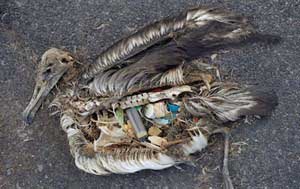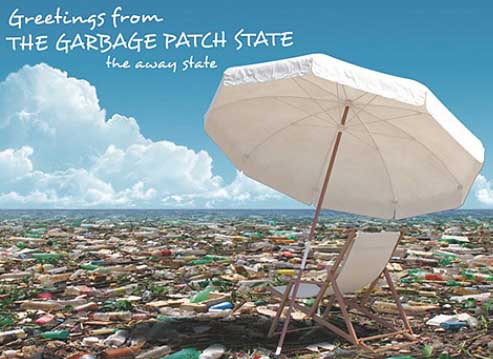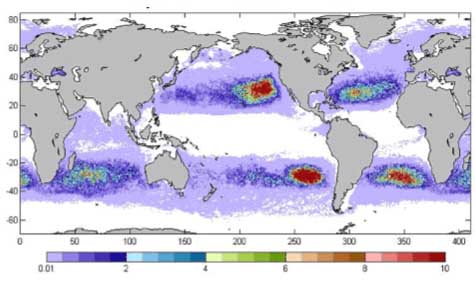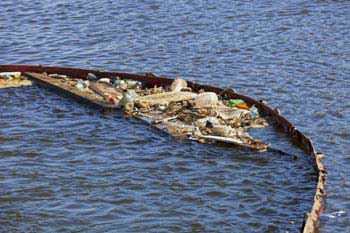Garbage Patches: Islands of Rubbish
Is a colossal amount of non-biodegradable waste (especially plastic) found across 5 'islands' in the Pacific, Atlantic and Indian Ocean.Garbage Patch is a colossal amount of non-biodegradable waste (especially plastic) found across 5 'islands' in the north and south Pacific, the north and south Atlantic and the Indian Ocean.

At the Unesco headquarters in Paris in April 2013, these islands of rubbish became a federal state in a performance installation that aimed to provide visibility to this terrible problem.
In order to get a grasp on how much rubbish is floating in our oceans, the entire surface area of the island of debris in the Pacific alone is 3 times as big as Spain! Unbelievable right? In total, it measures 16,000 km2.
It was discovered in 1997 by the oceanographer Charles Moore who ignored the recommendations to avoid that area of the Pacific, not a good area to sail due to the lack of wind and currents, and decided to take a route that ended up with such a horrible finding. However, there are reports on plastic debris in the oceans that date back to the 1970s.
From then, many scientists, environmentalists and others have studied it and especially carried out projects to try to discover how it affects the ecosystem and the food chain, such as the famous Project Kaisei or 5 Gyres.
The garbage patch in the North Atlantic was discovered in 2009 and is also linked to the North Atlantic Ocean Gyre. Estimates state that 80% of the rubbish that forms these islands comes from land and 20% from boats, according to the United Nations Environmental Programme..The size of these ginormous marine tips is appalling.
Garbage Patches: Effects on the marine ecosystem
Although it seems indestructible, plastic quickly decomposes (it starts within a year) due to the effects of the sun and water, and ends up becoming a terrible pollutant for the marine ecosystem given the toxic substances it releases and introduces into the food chain.

Small fish mistakenly feed off these pieces of plastic, which also soak up heavy metals. Those that do not die, when eaten by larger fish contribute to these toxic substances entering the food chain.
Birds also feed off this debris and estimates point to around 1 million marine birds and one hundred thousand marine mammals dying due to having ingested plastic every year. A study of the North Pacific shows that 8 out of every 11 dead birds were found with plastic in their stomachs.
In addition, this floating plastic debris affects the marine ecosystem as it can transport microbes and organisms from one area to another where they did not exist before. It also affects the usual photosynthesis process for algae and zooplankton. This alters the production of oxygen and creates an imbalance in the entire ecosystem.
Garbage Patches solutions
 Although over two decades have gone by, nobody has taken the decision to clean it up (with the excuse/reason that it is in international waters); nevertheless, interesting proposals have been made such as using the debris to make diesel. Only a 19 year-old student seems to have come up with a solution! However, his project is currently on hold. Another proposal has come from a group of North Korean researchers involving a type of giant spherical vacuum cleaner although none of the two proposals has yet to be implemented, despite the option from the student, Boyan Slat, possibly being entirely fruitful since it involves selling the large amount of plastic to recycling companies. Why not implement it then?
Although over two decades have gone by, nobody has taken the decision to clean it up (with the excuse/reason that it is in international waters); nevertheless, interesting proposals have been made such as using the debris to make diesel. Only a 19 year-old student seems to have come up with a solution! However, his project is currently on hold. Another proposal has come from a group of North Korean researchers involving a type of giant spherical vacuum cleaner although none of the two proposals has yet to be implemented, despite the option from the student, Boyan Slat, possibly being entirely fruitful since it involves selling the large amount of plastic to recycling companies. Why not implement it then?



